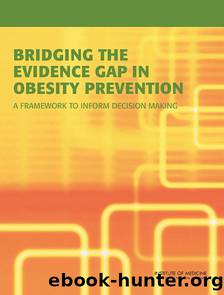Bridging the Evidence Gap in Obesity Prevention: A Framework to Inform Decision Making by Institute of Medicine of the National Academies

Author:Institute of Medicine of the National Academies
Language: eng
Format: epub
Tags: Food and Nutrition : Nutrition - Other
Publisher: NATIONAL ACADEMIES PRESS
Published: 2010-11-24T00:00:00+00:00
Evaluating the Effectiveness of Interventions
Traditional evidence syntheses emphasize assessment of the effectiveness of potential interventions. Similarly, the L.E.A.D. framework includes a synthesis of the evidence gathered, focused on helping the decision maker understand the likely outcomes of each potential intervention and the degree of certainty with which that projection can be made: What is the likely magnitude of the change to be expected with this intervention alone, or how dependent might the desired change be on combining this intervention with other components in a more comprehensive strategy or policy? How tightly linked are the immediate effects of the intervention to the goals of decreased caloric intake and increased energy expenditure? In addition, careful attention should be paid to the types of information included, as well as the standards used to evaluate each source of evidence, to determine the level of certainty of the causal link between an intervention and the observed outcomes (see Chapters 5 and 6 for further detail).
The relative importance of different types of evidence will depend on the decision-making context. Best and colleagues (2008a) view evidence according to two distinct spectra: an ecological perspective at the individual, organizational, and systems levels and a programmatic perspective within basic/discovery, clinical, and population research settings. The resulting matrix of evidence recognizes both the research setting, or context, in which the evidence was generated and the fact that mechanisms, actors, and actions will differ depending on whether individuals, organizations, or systems are targeted.
In general, the best evidence at the individual level, particularly in the discovery phase of research, will be derived from experimental or quasi-experimental studies (Best et al., 2008b; Rychetik et al., 2004). These approaches, including the use of statistical meta-analysis techniques, may yield quantitative estimates of the effectiveness of individual-level interventions (see Chapter 5 for more discussion of meta-analysis); however, intent-to-treat analysis of RCTs is the best way to minimize bias in ascertaining treatment effects in individual studies (Montori and Guyatt, 2001). Questions concerning systems and populations may best be answered using nonexperimental sources, such as descriptive research or qualitative analyses (Best et al., 2008b).
Program evaluation techniques evolve with program growth and complexity. In anticipating the types of data that may be available on interventions, Jacobs (2003) notes that while all programs should involve some sort of evaluation, evaluation capacities and interests are not static. For purposes of the present discussion, decision makers may expect that newer, smaller programs are more likely to have lower-quality evidence, while larger, more established programs are likely to generate higher-quality data more directly relevant to health outcomes.
Decision makers typically adapt or modify interventions to suit local conditions. This adaptation may influence the reported effectiveness of an intervention. One method used to transform information obtained from published reports into meaningful generalized guidance is a realist review (a type of mixed-method analysis used to synthesize evidence) (Pawson et al., 2005). As described by Greenhalgh and colleagues (2007, p. 858) in a recent Cochrane review of school feeding programs, â[a] realist review exposes and articulates the
Download
This site does not store any files on its server. We only index and link to content provided by other sites. Please contact the content providers to delete copyright contents if any and email us, we'll remove relevant links or contents immediately.
Parents as Care Managers by Gillian Bridge(697)
The Tapestry of Memory: Unraveling the Threads of the Mind by Bittner Karis & Chianese Gabriella & Priede PhD David L(540)
So Young, So Sad, So Listen: A Parents' Guide to Depression in Children and Young People by Philip Graham Nick Midgley(531)
Lucid Dying by Sam Parnia(472)
Vital Signs by Izzy Lomax-Sawyers(443)
Prepare the TCM License exam in a month Vol. 3: Acupuncture theory - channels, points, techniques and treatments(California, NCCAOM, Canadian exam) by Woosen Ur(391)
Oxford Textbook of Global Public Health by Roger Detels;Quarraisha Abdool Karim;Fran Baum;Liming Li;Alastair H Leyland;(358)
IVF Got This by Colette Centeno Fox(343)
The Censorship of Second Opinions: How the politics of "misinformation" captured healthcare during the Covid-19 pandemic by Ariel Herron(342)
Wilderness and Survival Medicine by Ellis Chris Breen & Dr Craig(280)
Introduction to Social Work Practice : A Practical Workbook by Herschel Knapp(279)
Eating and Growth Disorders in Infants and Children by Joseph L. Woolston(274)
How Data Happened by Unknown(258)
Boxed Set 1 Dermatology by Dr Miriam Kinai(256)
Selective Oxidation Catalysts Obtained by the Immobilization of Iron (III) Porphyrins on Layered Hydroxide Salts by Fernando Wypych Shirley Nakagaki & Guilherme Sippel Machado(246)
Zika Virus Biology, Transmission, and Pathways by Colin R. Martin(243)
Snake Oil: How Xi Jinping Shut Down the World by Michael P. Senger(237)
Positive health: 100+ research-based positive psychology and lifestyle medicine tools to enhance your wellbeing by Jolanta Burke Pádraic J. Dunne Trudy Meehan Ciaran A. O'Boyle Christian van Nieuwerburgh(233)
Global Health Governance and Commercialisation of Public Health in India by Anuj Kapilashrami Rama V. Baru(216)
